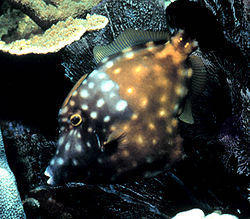Filefish
This article needs additional citations for verification. (May 2024) |
| Filefish | |
|---|---|

| |
| Stephanolepis hispidus | |
| Scientific classification | |
| Domain: | Eukaryota |
| Kingdom: | Animalia |
| Phylum: | Chordata |
| Class: | Actinopterygii |
| Order: | Tetraodontiformes |
| Suborder: | Balistoidei |
| Family: | Monacanthidae Nardo, 1843[1] |
| Genera[2] | |
|
See text | |
The filefish (Monacanthidae) are a diverse family of tropical to subtropical
The filefish family comprises about 102 species in 27 genera. More than half of the species are found in Australian waters, with 58 species in 23 genera.[3]
Their laterally compressed bodies and rough, sandpapery skin inspired the filefish's common name.
Description
Appearing very much like their close relatives the triggerfish, filefish are

The small terminal mouths of filefish have specialized incisor teeth on the upper and lower jaws. The upper jaw hase four teeth in the inner series and six in the outer series. The lower jaw has four to six in an outer series only. The snout is tapered and projecting, and the eyes are located high on the head. Filefish have rough non-overlapping scales with small spikes, which is why they are called filefish. Although scaled, some filefish have such small scales that they appear scaleless. Like the triggerfish, filefish have small gill openings and greatly elongated pelvic bones, creating a "dewlap" of skin running between the bone's sharply keeled termination and the belly. The pelvis is articulated with other bones of the "pelvic girdle" and is capable of moving upwards and downwards in many species to form a large dewlap, which is used to make the fish appear much deeper in the body than is actually the case. Some filefish erect their dorsal spine and pelvis simultaneously to make removing them from a cave more difficult for predators.
The largest filefish species is the

Habitat and life history

Adult filefish are generally shallow-water fish, inhabiting depths of no more than about 30 m (100 ft). They may be found in lagoons or associated with seaward reefs and seagrass beds; some species may also enter estuaries. Some species are closely associated with dense mats of Sargassum, a particularly ubiquitous "sea weed"; these filefish, notably the plane head filefish (Stephanolepis hispidus), are also coloured and patterned to match their weedy environments.
Either solitary, in pairs, or small groups depending on the species, filefish are not especially good swimmers; their small fins confine the fish to a sluggish pace. Filefish are often observed drifting head downward amongst stands of seaweed,[4] presumably in an effort to fool both predator and prey alike. When threatened, filefish may retreat into crevices in the reef.
The feeding habits of filefish vary among the species, with some eating only
Filefish spawn at bottom sites prepared and guarded by the males; both he and the female may guard the brood, or the male alone, depending on the species. The young filefish are
As food

In
Threadsail filefish (Stephanolepis cirrhifer) is a popular snack food in Korea. It is typically dried and made into a sweet and salty
Genera
- Acanthaluteres
- Acreichthys
- Aluterus
- Amanses
- Anacanthus
- Arotrolepis
- Brachaluteres
- Cantherhines
- Cantheschenia
- Chaetodermis
- Colurodontis
- Enigmacanthus
- Eubalichthys
- Lalmohania
- Meuschenia
- Monacanthus
- Navodon
- Nelusetta
- Oxymonacanthus
- Paraluteres
- Paramonacanthus
- Pervagor
- Pseudalutarius
- Pseudomonacanthus
- Rudarius
- Scobinichthys
- Stephanolepis
- Thamnaconus
See also
References
- ^ Bailly, N. (2015). "Monacanthidae Nardo, 1843". WoRMS. World Register of Marine Species. Retrieved 2016-01-12.
- ^ Matsuura, K. (2014): Taxonomy and systematics of tetraodontiform fishes: a review focusing primarily on progress in the period from 1980 to 2014. Ichthyological Research, 62 (1): 72–113.
- ^ Bray, D.J. (2012): Leatherjackets, MONACANTHIDAE, in Fishes of Australia, accessed 26 August 2014, http://www.fishesofaustralia.net.au/home/family/250 Archived 2020-05-21 at the Wayback Machine
- ^ Gumanao G.S., A.R. Bos & J.E. Randall (2018). "Seagrass Filefish, Acreichthys tomentosus (Linnaeus), a master of camouflage". Journal of the Ocean Science Foundation. 30: 58–72.
- FAO. p. 182. Archived from the original(PDF) on 2017-05-19.
